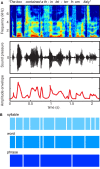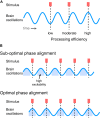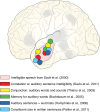Neural Oscillations Carry Speech Rhythm through to Comprehension
- PMID: 22973251
- PMCID: PMC3434440
- DOI: 10.3389/fpsyg.2012.00320
Neural Oscillations Carry Speech Rhythm through to Comprehension
Abstract
A key feature of speech is the quasi-regular rhythmic information contained in its slow amplitude modulations. In this article we review the information conveyed by speech rhythm, and the role of ongoing brain oscillations in listeners' processing of this content. Our starting point is the fact that speech is inherently temporal, and that rhythmic information conveyed by the amplitude envelope contains important markers for place and manner of articulation, segmental information, and speech rate. Behavioral studies demonstrate that amplitude envelope information is relied upon by listeners and plays a key role in speech intelligibility. Extending behavioral findings, data from neuroimaging - particularly electroencephalography (EEG) and magnetoencephalography (MEG) - point to phase locking by ongoing cortical oscillations to low-frequency information (~4-8 Hz) in the speech envelope. This phase modulation effectively encodes a prediction of when important events (such as stressed syllables) are likely to occur, and acts to increase sensitivity to these relevant acoustic cues. We suggest a framework through which such neural entrainment to speech rhythm can explain effects of speech rate on word and segment perception (i.e., that the perception of phonemes and words in connected speech is influenced by preceding speech rate). Neuroanatomically, acoustic amplitude modulations are processed largely bilaterally in auditory cortex, with intelligible speech resulting in differential recruitment of left-hemisphere regions. Notable among these is lateral anterior temporal cortex, which we propose functions in a domain-general fashion to support ongoing memory and integration of meaningful input. Together, the reviewed evidence suggests that low-frequency oscillations in the acoustic speech signal form the foundation of a rhythmic hierarchy supporting spoken language, mirrored by phase-locked oscillations in the human brain.
Keywords: intelligibility; language; oscillations; phase locking; speech comprehension; speech rate; theta.
Figures






 ), and the aspiration for a clear /ba/ in a region of high excitability (
), and the aspiration for a clear /ba/ in a region of high excitability ( ). However, for the ambiguous token, the aspiration occurs at different levels of excitability for the faster and slower speech rates (
). However, for the ambiguous token, the aspiration occurs at different levels of excitability for the faster and slower speech rates ( ), making it less likely to be perceived as /pa/ (and more likely to be perceived as a /ba/) at slower speech rates. (C) Schematic categorical perception curves demonstrating a shift of perceptual boundaries as a function of speech rate based on this framework.
), making it less likely to be perceived as /pa/ (and more likely to be perceived as a /ba/) at slower speech rates. (C) Schematic categorical perception curves demonstrating a shift of perceptual boundaries as a function of speech rate based on this framework.

Similar articles
-
Phase-locked responses to speech in human auditory cortex are enhanced during comprehension.Cereb Cortex. 2013 Jun;23(6):1378-87. doi: 10.1093/cercor/bhs118. Epub 2012 May 17. Cereb Cortex. 2013. PMID: 22610394 Free PMC article.
-
Phase Alignment of Low-Frequency Neural Activity to the Amplitude Envelope of Speech Reflects Evoked Responses to Acoustic Edges, Not Oscillatory Entrainment.J Neurosci. 2023 May 24;43(21):3909-3921. doi: 10.1523/JNEUROSCI.1663-22.2023. Epub 2023 Apr 26. J Neurosci. 2023. PMID: 37185238 Free PMC article.
-
Acoustic landmarks drive delta-theta oscillations to enable speech comprehension by facilitating perceptual parsing.Neuroimage. 2014 Jan 15;85 Pt 2(0 2):761-8. doi: 10.1016/j.neuroimage.2013.06.035. Epub 2013 Jun 19. Neuroimage. 2014. PMID: 23791839 Free PMC article.
-
Prediction and constraint in audiovisual speech perception.Cortex. 2015 Jul;68:169-81. doi: 10.1016/j.cortex.2015.03.006. Epub 2015 Mar 20. Cortex. 2015. PMID: 25890390 Free PMC article. Review.
-
The neural oscillations of speech processing and language comprehension: state of the art and emerging mechanisms.Eur J Neurosci. 2018 Oct;48(7):2609-2621. doi: 10.1111/ejn.13748. Epub 2017 Nov 14. Eur J Neurosci. 2018. PMID: 29055058 Review.
Cited by
-
Aging Affects Neural Synchronization to Speech-Related Acoustic Modulations.Front Aging Neurosci. 2016 Jun 15;8:133. doi: 10.3389/fnagi.2016.00133. eCollection 2016. Front Aging Neurosci. 2016. PMID: 27378906 Free PMC article.
-
Behavioral entrainment to rhythmic auditory stimulation can be modulated by tACS depending on the electrical stimulation field properties.Elife. 2024 Jan 30;12:RP87820. doi: 10.7554/eLife.87820. Elife. 2024. PMID: 38289225 Free PMC article.
-
Audiovisual speech perception: Moving beyond McGurk.J Acoust Soc Am. 2022 Dec;152(6):3216. doi: 10.1121/10.0015262. J Acoust Soc Am. 2022. PMID: 36586857 Free PMC article.
-
Enhancement of speech-in-noise comprehension through vibrotactile stimulation at the syllabic rate.Proc Natl Acad Sci U S A. 2022 Mar 29;119(13):e2117000119. doi: 10.1073/pnas.2117000119. Epub 2022 Mar 21. Proc Natl Acad Sci U S A. 2022. PMID: 35312362 Free PMC article.
-
Rehabilitation of aphasia: application of melodic-rhythmic therapy to Italian language.Front Hum Neurosci. 2015 Sep 24;9:520. doi: 10.3389/fnhum.2015.00520. eCollection 2015. Front Hum Neurosci. 2015. PMID: 26441615 Free PMC article.
References
-
- Abercrombie D. (1967). Elements of General Phonetics. Chicago: Aldine
Grants and funding
LinkOut - more resources
Full Text Sources
Other Literature Sources

